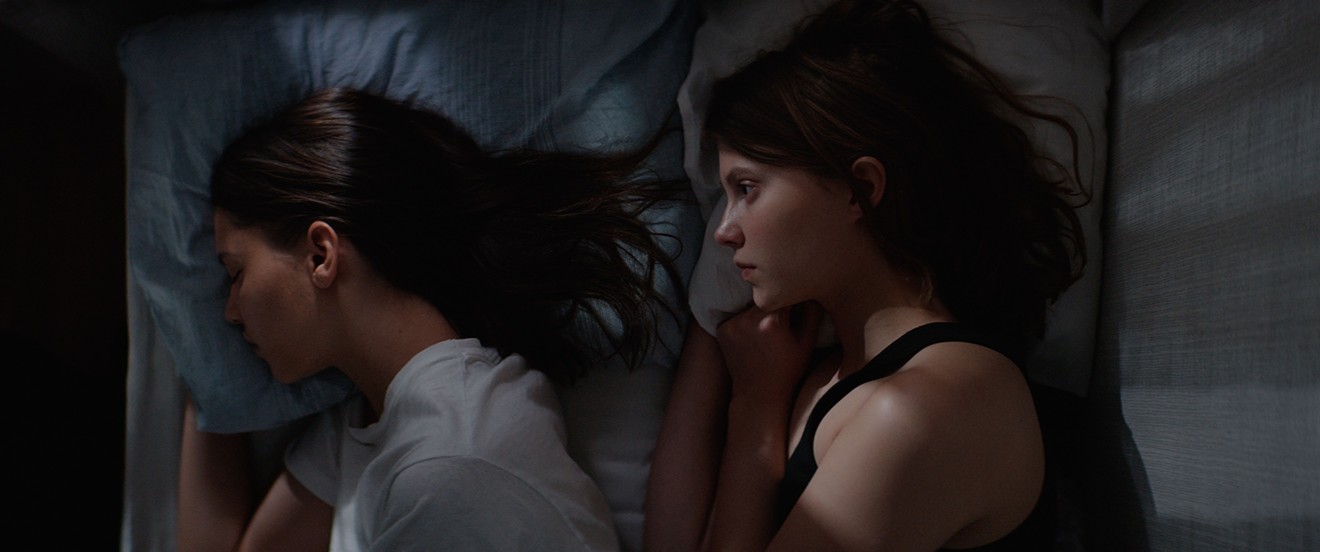Can we call Joachim Trier’s Thelma a horror movie? The story of a young woman whose mysterious seizures coincide with unsettling, possibly supernatural goings on around her, it certainly resembles one in its broad strokes. And with Trier’s brooding, precise stylization, it does cast a disturbing spell. But horror turns on helplessness, on pulling viewer and protagonist into a world that, on some basic level, they want no part of. Thelma starts with that idea, but moves away from the monstrous, toward compassion and understanding. Like an emo Carrie, it probes the profound underlying sadness beneath tales of possession. It makes vivid the protagonist’s loneliness and despair.
The movie’s one genuinely shocking scene is its first, following a young girl and her father on a hunting trip in a remote corner of Norway. Dad takes aim at a fawn, but then, unbeknownst to the girl, turns the rifle on her. He hesitates, however, and the next thing we know it’s a decade or so later, and Thelma (Eili Harboe) is now a shy, wide-eyed freshman in college in Oslo, studying biology. But all is clearly not right with her — as we realize when she suffers a seizure in the library and black crows start hitting the windows. Was dear old murderous dad onto something all those years ago?
Thelma soon meets Anja (played by the Norwegian-American musician Kaya Wilkins), a beautiful fellow coed who takes an immediate liking to her. The evident spark between the two of them continues to flare, and one night Thelma seems to call Anja to her bedside through the sheer power of her mind. The devout Thelma isn’t sure how to feel about their attraction, and when Anja starts caressing her leg as they watch a modern dance performance set to Philip Glass’ second symphony, Thelma’s agony starts to manifest itself telepathically — a huge hanging section of the Oslo Concert Hall’s ceiling starts to sway back and forth, presaging a potential catastrophe.
The way Trier weaves all these elements together — Glass’ throbbing, repetitive music, Thelma’s nauseating anxiety, the eroticism of Anja’s caresses, that slowly swinging ceiling — is nothing short of intoxicating, and it’s just one of the many bravura set pieces in the picture. But unlike, say, a Brian De Palma or a William Friedkin (The Exorcist is also clearly a touchstone), the director’s approach to narrative remains understated despite intimations of the paranormal. He doesn’t dwell on unexplained physical or natural phenomena. Thelma’s seizures call ominous flocks of crows to her, but don’t expect an aviary apocalypse a la Hitchcock. Instead, the birds become a visual motif that’s echoed in other elements of the film: impossibly high camera angles, black-clad ballet dancers flopping their wings — as if the idea of God’s judgment were pulsating all around our characters.
Although it goes beyond a mere stylistic device, the supernatural here often feels like a function of Thelma’s loneliness and inner turmoil. She herself isn’t sure what’s going on, so why should we be? Uncertainty doesn’t lend itself to contemporary horror’s jump scares; instead, we get a more existential kind of terror, one that inspires us to use our imaginations. What, exactly, is Thelma capable of? Most of the time, all we can do is guess. (Though one brief moment late in the film, involving a strand of hair and a very large window, implies the answer: a whole lot.)
With so much buildup, we’d expect all this to lead to some big, bloody denouement, when we witness the full extent of our heroine’s powers and see cinematic justice meted out, no? Not quite. Trier doesn’t exactly leave us hanging, but he seems less interested in explaining the specifics of Thelma’s case or delivering basic genre pleasures than he is in exploring the emotional valence of her powers, and the repressed feelings they portend. Almost as frequent as those flocks of crows, those judgmental birds’ eye angles, are visions of ice and water and submersion — the moral opprobrium of the universe locked in conflict with the suffocating agony of a young woman unable to be herself. So yes, Thelma is a horror movie — a lovely, transfixing one — but don’t look to it for cheap scares. The terror here cuts far deeper.
[
{
"name": "Air - MediumRectangle - Inline Content - Mobile Display Size",
"component": "19274298",
"insertPoint": "2",
"requiredCountToDisplay": "2"
},{
"name": "Editor Picks",
"component": "17482312",
"insertPoint": "4",
"requiredCountToDisplay": "1"
},{
"name": "Inline Links",
"component": "18711090",
"insertPoint": "8th",
"startingPoint": 8,
"requiredCountToDisplay": "7",
"maxInsertions": 25
},{
"name": "Air - MediumRectangle - Combo - Inline Content",
"component": "17482310",
"insertPoint": "8th",
"startingPoint": 8,
"requiredCountToDisplay": "7",
"maxInsertions": 25
},{
"name": "Inline Links",
"component": "18711090",
"insertPoint": "8th",
"startingPoint": 12,
"requiredCountToDisplay": "11",
"maxInsertions": 25
},{
"name": "Air - Leaderboard Tower - Combo - Inline Content",
"component": "17482313",
"insertPoint": "8th",
"startingPoint": 12,
"requiredCountToDisplay": "11",
"maxInsertions": 25
}
]











